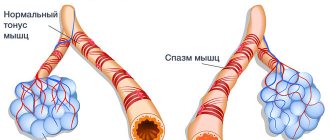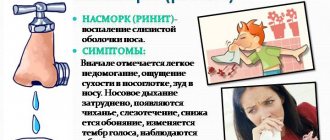Definition of disease
Chronic rhinitis, more popularly known as “chronic runny nose,” is an acute inflammatory disease of the nasal mucosa. It is “activated” after any hypothermia or a viral infection in the nose. This leads to a persistent decrease in local immunity, making the body more vulnerable to any infections.
In some cases, chronic runny nose is not an independent disease, but a symptom of diseases such as sinusitis or adenoiditis.
A chronic runny nose can be completely cured only by eliminating its root cause. This must be done, since chronic rhinitis can significantly worsen the quality of life. Constant nasal congestion, sleep disturbances, headaches and decreased performance are all consequences of a chronic runny nose. Proper treatment of chronic runny nose and strengthening the immune system will help avoid this problem in the future.
There are such types of chronic runny nose as:
- Atrophic;
- Hypertrophic;
- Catarrhal;
- Allergic;
- Vasomotor.
Classification of rhinitis or chronic runny nose
Regardless of the type, the disease begins as acute rhinitis. If not treated correctly, it eventually becomes chronic with periodic exacerbations.
Chronic runny nose: treatment with folk remedies
In this case, simply prescribing powerful drugs (for example, hormonal drugs) is very harmful. An integrated approach is important, which involves assessing the state of immunity, taking into account the presence of chronic diseases, overwork, stress, bad habits and lifestyle analysis. Therefore, the most significant steps in the treatment of chronic rhinitis will be:
- Getting rid of household dust, allergens, feather pillows, purchasing an ionizer and air purifier;
- The use of antiviral drugs both for local prevention (oxolinic ointment) and to fight infection: “Anaferon”, “Arbidol”, “Viferon” in the form of suppositories;
- Examination of a smear and culture of nasopharyngeal discharge for microflora;
- Use of physiotherapeutic procedures (quartz, UHF);
- Hardening the body and increasing nonspecific resistance to infections.
Finally, chronic rhinitis can be of a vasomotor nature, and develop as a reaction to the constant use of vasoconstrictor drugs. In this case, such treatment with decongestants should be stopped for a long time.
In conclusion, I would like to note that all medications should be prescribed by a doctor. As self-medication, you can use nasal rinsing, inhalation, and also warming up.
It is important to avoid hypothermia, since rhinitis has a seasonal autumn-spring character.
Causes
The most common cause of chronic runny nose is improper treatment of a viral infection or excessive use of vasoconstrictor drops. The second most common cause of chronic runny nose is seasonal allergies. In this case, a runny nose becomes only a symptom of the underlying disease.
Sometimes the cause of chronic runny nose is a hereditary predisposition to such problems.
There are other causes of chronic runny nose:
- Incorrect treatment of acute rhinitis that occurs as a symptom of a viral infection.
- Congenital or acquired deformation of the nasal septum.
- Constant irritation of the nasal mucosa by caustic chemicals or sudden temperature changes.
- Pathologies of the endocrine and cardiovascular systems that cause impaired blood supply to the nose.
- Adenoiditis of varying degrees.
- Neoplasms in the nasopharyngeal cavity.
- Nose injuries.
Correctly determining the cause of chronic runny nose is the key to successful treatment. Over time, a chronic runny nose leads to atrophy of the nasal mucosa.
Varieties and types of chronic runny nose
- Catarrhal rhinitis is manifested by a delay in the inflammatory process in the mucous membranes of the nose. It appears after frequent infections and colds. Symptoms of catarrhal rhinitis are: mucous discharge, swelling and congestion of the nasal sinuses, deterioration of breathing and sense of smell. This form of runny nose in children is directly related to chronic diseases, in particular tonsillitis and adenoiditis. If not treated correctly, it can develop into a hypertrophic form of runny nose.
- Hypertrophic rhinitis is a complicated form of catarrhal. The reasons for its appearance may be long-term use of nasal drops, incorrect shape of the septum, or inhalation of harmful fumes. This disease can only be completely cured by surgery. Symptoms of the hypertrophic form of the runny nose: difficulty breathing, pain in the head, hearing loss, voice distortion.
- Atrophic runny nose is atrophy of the mucous membranes of the nose or its cartilaginous parts. The cause of its manifestation can be injuries, allergies, colds, decreased immunity; with this disease, a crust forms in the nose, which is very easily injured. When trying to remove them, bleeding occurs. In rare cases, the patient feels dryness, unpleasant odor and tightness.
- Allergic rhinitis most often manifests itself in a seasonal chronic form. For a person who suffers from such rhinitis, the slightest contact with the allergen will be enough for further prolonged congestion of the nasal sinuses, during which there is no mucous discharge, but sneezing attacks are extinguished. If there are no objects nearby that cause allergies, then the person feels great.
- Vasomotor runny nose appears from general changes or disturbances in the human body (for example, jumps in hormonal levels). This type of runny nose occurs quite often in pregnant women.
Chronic runny nose should always be treated at the first symptoms!
A runny nose is not capable of causing harm to human health, but in the complete absence or incorrect treatment, there is a great risk of spreading viruses or infection to nearby organs or tissues. It is in such cases that severe complications appear, such as sinusitis, tonsillitis, ethmoiditis, acute otitis media, laryngitis or pharyngitis and many others.
Treatment of a runny nose should begin from the first days of the appearance of the first symptoms. Prescribing strict bed rest will allow the patient to rest, as well as protect surrounding people from infection.
Symptoms
There are characteristic signs that allow you to identify a chronic runny nose and distinguish it from temporary cold symptoms:
- Chronic nasal congestion;
- Difficulty in nasal breathing;
- Periodic swelling of the mucous membrane;
- Impaired sense of smell;
- Dry mucous membranes;
- Itching and thinning of the nasal mucosa;
- Headache;
- Redness and watery eyes.
A characteristic symptom is more severe swelling when lying on your side. At the same time, the opposite side swells more. That is, when lying on the right side, the left side swells more and vice versa.
Treatment of chronic runny nose should be aimed primarily at eliminating the root cause. By eliminating only the symptoms, you can only temporarily mask the existing problem.
Symptoms of chronic rhinitis
To know how to cure chronic rhinitis, you need to correctly determine the cause of its occurrence. Otherwise, the treatment will not be effective and may worsen the course of the disease. The symptoms of chronic rhinitis will help in making the correct diagnosis; from them you can determine what type of rhinitis it is.
Let's consider all types of runny nose in adults:
- Vasomotor runny nose (rhinitis vasomotorica), depending on the predominance of one or another symptom, can be a hypersecretory form, when the main complaint is significant nasal discharge; vasodilator (the leading symptom is nasal congestion) and combined (vasodilator-hypersecretory) forms, when the patient is bothered by both significant nasal discharge and difficulty in nasal breathing. The allergic form can be seasonal or permanent.
- Atrophic chronic. Symptoms: thinning of the nasal mucosa, expansion of the nasal passages, a feeling of dryness in the nose, secretion of thick mucus, the formation of crusts on the mucous membrane, difficulty breathing through the nose, impaired sense of smell. When removing crusts from the mucous membrane, slight bleeding or an ulcer may form.
- Chronic catarrhal - characterized by patient complaints of constant mucous discharge from the nose and periodic difficulty in nasal breathing with alternating blockage of one or the other half of the nose. Anterior rhinoscopy revealed hyperemia of the mucous membrane with a cyanotic tint, edema, and the presence of mucous discharge, especially at the bottom of the nasal cavity. After lubricating the nasal mucosa with vasoconstrictor solutions, a significant decrease in the volume of the tissues of the lower and middle turbinates occurs, which indicates the presence of false hypertrophy, i.e. swelling.
- Chronic hypertrophic - characterized by hyperplasia of the mucous membrane, often involving the periosteum and bone tissue of the turbinates and can be diffuse and limited in form. Most often, growth and thickening of the mucous membrane occurs on the inferior nasal concha, less often on the middle one in places where cavernous tissue is localized.
- Allergic - manifested by watery mucus discharge from the nose with itching, burning, and bouts of sneezing. The causes of allergic rhinitis are usually: house dust, mites living in house dust, tobacco smoke, flakes of skin or animal hair, fungal spores, cobwebs, etc. It can be year-round.
- Ozena (ogaepa) is a severe form of atrophic process in the nose, spreading both to the mucous membrane and to the bone walls of the nasal cavity and turbinates with the production of quickly drying discharge with a strong specific, unpleasant odor.
In the absence of adequate treatment, rhinitis can lead to complications such as sinusitis, sinusitis, nasal polyps, and inflammation of the middle ear.
Possible complications
Chronic rhinitis often leads to oxygen starvation of the body, which affects the overall well-being and performance of a person. Chronic runny nose without adequate treatment can lead to future health problems such as:
- Decreased local immunity;
- Pharyngitis;
- Tracheitis;
- Obstructive bronchitis;
- Pneumonia;
- Otitis.
A constant source of infection in the nasopharynx often leads to the development of stomatitis, caries or other dental diseases. This often leads to thinning and drying of the mucous membrane of not only the nose, but also the mouth.
Chronic runny nose can lead to the development of adenoiditis, polyps or cysts in the nose in the future.
If we are talking about the chronic form of allergic rhinitis, its advanced form can even lead to the development of bronchial asthma.
Treatment
Comprehensive treatment of chronic rhinitis should begin with a detailed diagnosis. To do this, you should consult an ENT doctor. The examination begins with collecting a detailed medical history. The simplest research method is anterior rhinoscopy, which allows you to assess the condition of the nasal cavity. In children, a digital examination is performed to exclude adenoids. In order to determine the specific type of chronic runny nose, the following types of studies may be needed:
- Anterior rhinoscopy with preliminary instillation of vasoconstrictor drops;
- Examination of the pharynx and tonsils;
- X-ray of the sinuses;
- Clinical blood test;
- Tank. culture of nasal discharge;
- Study of microflora for sensitivity to antibiotics;
- Examination of nasal discharge for eosinophils.
If necessary, a histological examination of the cells of the nasal mucosa, as well as computed tomography or magnetic resonance imaging, is performed. For allergic rhinitis, it is additionally necessary to do allergy tests.
Chronic runny nose can be almost completely cured at home, but under the supervision of a physician. At the same time, carrying out some procedures, primarily physiotherapy, is impossible at home.
The algorithm for complex treatment of chronic runny nose in each specific case depends on its specific type. Vasomotor, allergic and atrophic rhinitis are the most difficult to treat. Physiotherapy methods such as:
- UFO – therapy;
- UHF therapy;
- Magnetotherapy;
- Tube-quartz;
- Acupuncture;
- Electrophoresis (with solutions of sodium chloride or hydrocortisone);
- Thermal procedures on the nasal area (for example, microcurrents).
If the cause of a chronic runny nose is a deviated nasal septum, polyps or cysts in the nose, surgical treatment may be necessary to completely eliminate the symptoms.
By medication
Allergic rhinitis is almost impossible to completely cure, so symptomatic treatment is most often used. It includes the use of hyposensitizing agents in combination with the ingestion of antihistamines, as well as irrigation of the nasal mucosa with antihistamine sprays. Enterosorbents, immunocorrective therapy and specific immunotherapy are also used.
Vasoconstrictor drops included in the treatment of chronic runny nose cannot be used without a doctor’s prescription. The course of treatment should not be longer than 5 – 7 days.
Treatment of the atrophic form of rhinitis is also mainly symptomatic, that is, aimed at eliminating discomfort:
- Moisturizing the nasal mucosa with seawater-based sprays;
- Application of oil drops;
- The use of vasoconstrictor drops;
- Inhalations with saline solution or mineral water;
- Lubricating the nasal mucosa with glycerin in combination with iodine solution.
Additionally, therapy is used, including taking vitreous or placenta preparations.
Treatment of hypertrophic rhinitis requires the mandatory use of hormonal drugs.
Treatment of hypertrophic rhinitis is aimed at preventing pathological proliferation of connective tissue. For this purpose, an injection of hydrocortisone solution, as well as sclerosing drugs, is used into the overgrown mucosa. In particularly difficult cases, surgical treatment may be necessary to remove the overgrown tissue.
Treatment of chronic rhinitis of any type is a rather lengthy process, so you should be patient.
Drug treatment of catarrhal rhinitis includes:
- The use of vasoconstrictor drops in courses;
- Instillation of antibacterial drops, such as Bioparox or Isofra);
- Lubricating the nasal mucosa with local antiseptics, as well as antibacterial ointments;
- Application of oil drops.
If conservative therapy does not give the expected effect, the doctor may decide on the need for surgical treatment. A good effect is achieved by combining traditional therapy with traditional methods of treatment.
Folk remedies
In most cases, treatment of chronic runny nose is carried out at home. In this case, a variety of home methods are often used to complement the main therapy. The most popular method is rinsing the nasal cavity with saline solution. To do this, you can use a ready-made saline solution, or prepare such a solution yourself. For this you only need:
- 1 teaspoon salt;
- 1 liter of warm water.
It is easy to rinse your nose with this solution using a regular syringe with the needle removed. This will help effectively remove mucus and pathogenic microbes, as well as moisturize the mucous membrane. Methods such as:
- Rinsing the nose with an infusion of mint leaves (pour 500 grams of crushed mint leaves into 1 liter of boiling water, then strain);
- Lubricating the nasal mucosa with slightly warmed eucalyptus oil;
- Instillation of peach oil into the nose;
- Instillation of aloe juice into the nose in combination with water (freshly squeezed aloe juice is mixed with mineral water in a 1:1 ratio).
A good effect is obtained by rinsing the nose with a solution of sea salt in combination with eucalyptus oil. This helps to simultaneously cleanse and moisturize the mucous membrane, freeing up nasal breathing.
Before using any home remedies, you should consult your doctor.
Other effective recipes
Chronic runny nose can be treated with folk remedies both in the acute period and when symptoms subside. Alternative medicine provides a huge number of time-tested recipes that can quickly improve the patient's condition without harm to health. There are a large number of recipes that can quickly relieve symptoms of rhinitis.
Thuja oil. Thuja oil, which should be instilled into the nose, 2 drops three times a day, will help relieve nasal congestion and improve nasal breathing. This remedy can be used to treat runny nose in children and adults, as well as pregnant women and nursing mothers.
You may be interested in the article - How to properly use thuja oil for a runny nose in children?
Menthol oil. An effective remedy for the treatment of severe runny nose and nasal congestion. This product can be instilled into the nose, used for inhalation, or rubbed into the forehead or temples.
Beet juice. Beetroot juice will help cope with the signs of a chronic runny nose. To prepare the drops, you will need 1 small root vegetable, which must be peeled and grated. Using clean gauze, squeeze out the juice and put it in the refrigerator for 3 hours. Before instillation, it must be diluted with water in a 1:1 ratio. In the first 2 days, you need to drip beet juice every 3 hours, then three times a day, 2 drops in each nostril.
Mustard baths. Mustard foot baths are good for prolonged rhinitis. A guy's feet should be done before going to bed. After the procedure, your feet should be dried and put on warm socks. To prepare a bath, you need to take 1 tbsp of dry mustard per 2 liters of water.
Garlic or onion juice. Proven recipes to eliminate the manifestations of chronic rhinitis. To prepare them, you need to chop the selected root vegetable, squeeze out the juice, and put it in the refrigerator for 4 hours. Before instillation, garlic or onion juice is diluted with water in a ratio of 1:3. You need to instill 2 drops into each nasal passage twice a day.
Laundry soap for runny nose. To prepare such a product you will need 72% brown laundry soap. After moistening the soap with water, they need to lather a cotton swab or ear swab and treat the nasal passages. You can perform such procedures up to 4 times a day.
These are not all recipes that allow you to treat chronic rhinitis, but still, before self-medicating, you need to consult a doctor who will definitely tell you how to cure a runny nose, give useful recommendations, and, if necessary, draw up an individual treatment regimen. Many doctors are not supporters of traditional medicine, but reviews of patients who preferred to treat a runny nose using traditional methods indicate their effectiveness and good tolerability. Experts in the field of otolaryngology are of the opinion that folk remedies for chronic runny nose can only act as an additional treatment to the main therapy or a prophylactic agent to reduce the frequency of exacerbations.
Prevention
The best way to treat chronic rhinitis is its timely prevention. First of all, this is the timely treatment of viral infections and seasonal colds, a symptom of colds is a runny nose. In addition, there are general recommendations to help prevent the development of chronic rhinitis:
- Correct and timely treatment of acute viral rhinitis;
- Timely treatment of all diseases of the nasopharynx under the supervision of an otolaryngologist;
- Strengthening local and general immunity;
- Active lifestyle, including daily walks in the fresh air and sports;
- The use of saline solutions and sprays to moisturize the mucous membranes in rooms with dry air.
Another important factor is clean and cool indoor air. To do this, you should regularly ventilate the room, do wet cleaning and stop smoking.
Beneficial properties of bananas and their use in folk medicine to treat coughs
What herbs to drink for an adult with a dry cough are described in this article.
Cough inhalations //drlor.online/diagnostika-lechenie/kashel/allergicheskogo-s-pomoshhyu-ingalyacij.html
Drops
One of the main methods of folk therapy for rhinitis is the use of nasal drops. Making your own products can be effective.
The most popular drop recipes:
- Garlic drops. Take a small clove of garlic and grate it on a fine grater. Pour the mixture with vegetable oil, which has been heated in a water bath. Let the product sit for about six hours. Strain and drop into your nose.
- Drops based on aloe juice. To make this product, you need to take an aloe or Kalanchoe leaf. Squeeze the juice from the leaves. Dilute with water in equal proportions. Drip the finished medicine into your nose 3 times a day.
- Vegetable drops. Take beets and carrots. Grate them. Squeeze out the finished pulp, and mix the finished juice with vegetable oil in equal proportions. Add two drops of garlic juice. This remedy is dripped three times a day.
- Onion drops. Peel the onion and chop it finely. Add a spoonful of honey and a glass of water to the finished mixture. Let it brew for about two hours.
- Bay leaf drops. Chronic rhinitis in adults is treated with bay leaves. They are mixed with salt (half a spoon), honey and boiling water. Mix well and leave for about an hour.











